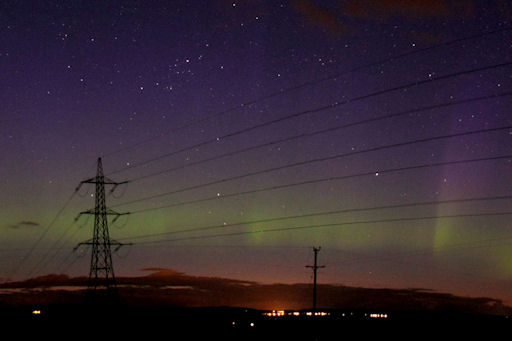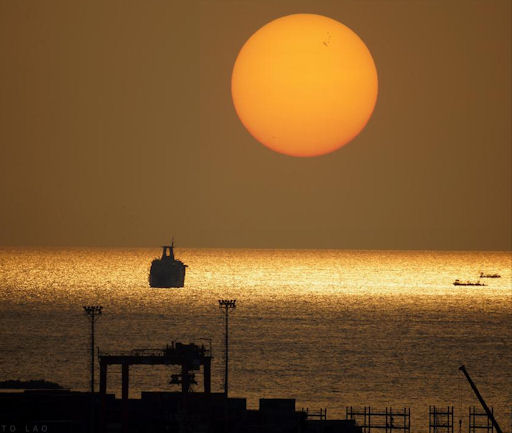CHANCE OF FLARES: Huge sunspot AR1476 is crackling with M-class solar flares and appears to be on the verge of producing even stronger blasts. The sunspot's 'beta-gamma-delta' magnetic field harbors energy for X-class flares, the most powerful kind. Eruptions in the days ahead will likely be geoeffective as the sunspot turns to face Earth. Solar flare alerts: text, phone.
NORTHERN LIGHTS: A solar wind stream hit Earth's magnetic field during the late hours of May 8th, stirring geomagnetic activity and auroras over parts of Europe. Graeme Whipps photographed the display from Scotland:
"A fantastic green and purple arc was clearly visible in the late twilight glow over Aberdeenshire," says Whipps. "I wasn't expecting this!" The full-sized image also frames a meteor slicing through the Northern Lights.
A pair of CMEs en route to Earth could add to the effect of the solar wind stream, igniting even brighter auroras during the next 24-48 hours. NOAA forecasters estimate a 40% chance of geomagnetic storms on May 9th.
more images: from Adrian Maricic of Loch Leven, Fife, Scotland; from Ronan Newman of Charlestown, Co Mayo, Ireland; from Martin McKenna of Mussenden Temple, Derry Coast, N. Ireland
SUNSPOT SUNSET: Sunspot AR1476 is so large, people are noticing it without the aide of a solar telescope. The behemoth appears at sunrise and sunset when the light of the low-hanging sun is occasionally dimmed to human visibility. Alberto Lao sends this picture from Manila, the Phillippines:
"The sky was hazy and a bit cloudy today, [perfect for sunspot photography]," says Lao. "Hoping to get a glimpse of AR 1476, I waited until a few minutes before sunset to try to image the sun . My patience was rewarded."
With at least four dark cores larger than Earth, the sprawling active region is one of the largest sunspots in years. Moreover, it has a 'beta-gamma-delta' magnetic field that harbors energy for X-class solar flares. Any eruptions in the days ahead could be Earth-directed as the sunspot turns to face our planet. Solar flare alerts: text, phone.
Caution: Even when the sun is dimmed by clouds and haze, looking into the glare can damage your eyes. Looking through unfiltered optics is even worse. If you chose to photograph the low sun, use the camera's LCD screen for viewfinding.

![]()
Solar wind
speed: 536.3 km/sec
density: 3.9 protons/cm3
explanation | more data
Updated: Today at 1701 UT
![]()
X-ray Solar Flares
6-hr max: M4 1232 UT May09
24-hr: M4 1232 UT May09
explanation | more data
Updated: Today at: 1700 UT
![]()
![]()
![]()
Daily Sun: 09 May 12
![]()
![]()
Sunspot 1476 poses a threat for X-class solar flares. Also, new sunspots are emerging at the circled location, Credit: SDO/HMI
![]()
![]()
![]()
Sunspot number: 90
What is the sunspot number?
Updated 08 May 2012
Spotless Days
Current Stretch: 0 days
2012 total: 0 days (0%)
2011 total: 2 days (<1%)
2010 total: 51 days (14%)
2009 total: 260 days (71%)
Since 2004: 821 days
Typical Solar Min: 486 days
Updated 08 May 2012
The Radio Sun
10.7 cm flux: 123 sfu
explanation | more data
Updated 08 May 2012
![]()
![]()
![]()
Current Auroral Oval:
![]()
Switch to: Europe, USA, New Zealand, Antarctica
Credit: NOAA/POES
![]()
![]()
![]()
Planetary K-index
Now: Kp= 4 unsettled
24-hr max: Kp= 4 unsettled
explanation | more data
![]()
Interplanetary Mag. Field
Btotal: 8.3 nT
Bz: 0.5 nT south
explanation | more data
Updated: Today at 1706 UT
![]()
![]()
![]()
Coronal Holes: 09 May 12
![]()
![]()
Solar wind flowing from this coronal hole is buffeting Earth's magnetic field. Credit: SDO/AIA.






